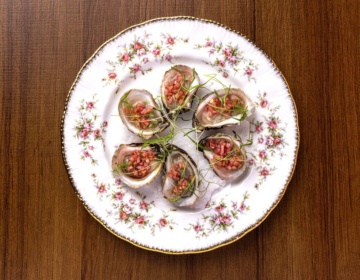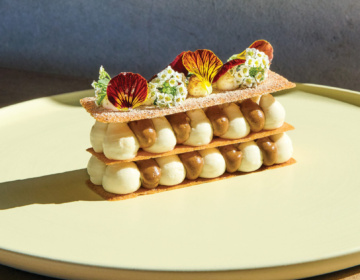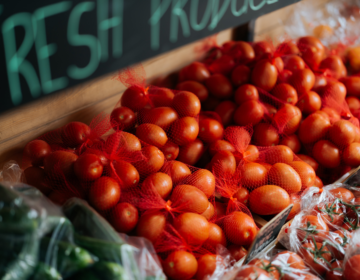We talked to Pei Pei Chei Ow owner about his Edmonton-based Indigenous food and education company, and the inextricable ties between food, community, and the land.
Scott Jonathan Iserhoff didn’t grow up dreaming of opening a restaurant and education company, but looking back through his colorful youth and dynamic career, one gets the sense Scott is fulfilling his destiny in the kitchen and in the community. Scott grew up in Timmins, Ontario, but many of his formative memories were created during his family's frequent visits to Attawapiskat, a First Nation in northern Ontario.
“Our people are known as Āhtawāpiskatowi ininiwak, or People of the Parting of the Rocks,” he said. A deep-rooted sense of togetherness permeated his experiences in Attawapiskat, which is simply the way of his people. “We do not knock on doors if we’re visiting. We walk in and we know that there is always a pot of tea and bannock ready for us,” he said.
As Scott grew up, he watched his family build tipis, fires, and break down a moose and distribute its parts through the community. These experiences instilled in him a sense of deep care; a virtue that often follows chefs into their kitchens and is tasted in their dishes. “My family was always busy harvesting and feeding others,” he said. It’s no surprise that all these years later, Scott finds himself inspired by his Elders in his work at Pei Pei Chei Ow (Pronounced “pe-pe-s-chew”), an Indigenous food and education company based in Amiskwacîwâskahikan—also known as Edmonton, Alberta—on Treaty 6 Territory.
We talked to Scott about growing up in the kitchen, the significance of Indigenous cooking, and how he uses Pei Pei Chei Ow to foster a sense of pride and connection.
On growing up surrounded by Indigenous cuisine and culture.
Food has been a driving force in Scott’s life for as long as he can remember. His earliest memories revolve around mealtimes, and even those memories are tied to the seasons—which makes sense, given that Indigenous cooking is all about following the natural rhythm of life. While seasonality and sustainability have become standard trends in most modern kitchens, these practices have long been embedded into the fabric of Indigenous cooking. “Harvesting blueberries mid-summer, gathering Labrador leaves and the muskeg all year round, fish fries along the shorelines of Northern Ontario, and eating smoked geese and dumplings with my kokum and moshom (grandmother and grandfather) are some of my favorite memories,” he said.
One of the most important techniques Scott learned from his family was how to cook over a flame.
“The years I spent watching my family prepare meals over the fire have taught me everything I know about using fire as a diverse technique to prepare dishes.
On finding his way to the kitchen.
Despite the fact that Scott’s upbringing was shaped by food and Indigenous cooking, he never considered the possibility of being a chef. That all changed when he saw chef David Wolfman of the Xaxli'p First Nation on TV. “He is an Indigenous Chef who would talk about wild salmon, venison, moose, duck, rabbit, and about the importance of eating our traditional food and how healthy it is. In him, I found inspiration” Scott said.
Scott went on to enroll in culinary school but was unable to connect to the colonial, Eurocentric methods of cooking and cuisines. After leaving the program and getting a hospitality degree in Toronto, he began to find his groove working in various kitchens and restaurants. The grueling hours and non-stop hustle of restaurant kitchen culture eventually led Scott to a path chefs know all too well—severe burnout. To take a break from the grind, he took on a position as a kitchen coordinator at a youth shelter.
“I noticed many of the youth accessing the services were Indigenous, and how they would gravitate towards me because I was someone they could relate to,” he said. He used this opportunity to prepare Indigenous dishes like braised neck bones, hearty stews, and root vegetables. Seeing how the youth would light up at these familiar, comforting meals was a lightbulb moment for Scott. “That’s when it clicked, how food really is medicine. How important it is.” Eventually, this sentiment would grow into the opening of Pei Pei Chei Ow.
On Indigenous cuisine and its ties to the land.
Indigenous cooking is inextricably tied to the land—ingredients are only ever seasonal, no parts of a hunted animal are wasted, and the process of hunting, foraging, and preparing food is always conducted with the utmost respect for the cycle of life.
“Animals and plants give their lives to us to feed us. That is why it’s important to treat them with honor and make sure nothing is wasted,” Scott said. When geese or ducks are plucked, their feathers are used to make pillows. When a moose or bison is butchered, every part of its body is utilized—the marrow from the bones are eaten, the moose's nose is used for soup, and the skin and other body parts are used to make clothing or tools. “Each part of an animal has different properties and benefits, whether they’re edible or not,” Scott said. Unlike the typical Western methods of food preparation, Indigenous cooking is inherently conscious—nothing is rushed, nothing is wasted. Naturally, producing food with less waste makes for a more sustainable method of consumption, further respecting the planet and the natural cycle of things.
On Pei Pei Chei Ow, community, and education.
In 2018, Scott’s wife, Svitlana, encouraged him to put together a pop-up dinner, and that was the day Pei Pei Chei Ow was truly born. The company’s name means robin in Omushkegowin—or Swampy Cree, the language of Scott’s people. “It was a name my Moshom gave me. The name represents the language, the culture, but it also honors my family and gives attention to an underrepresented group,” he said.
Today, Pei Pei Chei Ow operates as a multi-part operation. There’s a brick-and-mortar space located in Whiskeyjack Art House, a collaborative space that brings together Indigenous food, art, and community. Then there’s the educational piece; cooking classes, community outreach, and youth programs. “It’s important to let people know where their food comes from. Potatoes, corn, pumpkins, lobster, and anything that comes from the coast; all these are Indigenous foods,” Scott said.
Bringing an additional layer of awareness to food preparation and consumption is right in line with the Indigenous way of living—and eating. It’s equally important for Scott to use his company to break stereotypes and educate people about how diverse Indigenous nations are. “We have different cultures, languages, and different food systems as well.”
The true heartbeat of Pei Pei Chei Ow resembles that of Scott’s youth spent in Attawapiskat; centered around bolstering the community, honoring Elders, and passing down Indigenous traditions to younger generations. “What I find even more important than educating settlers is mentoring Indigenous youth who want to learn more,” Scott said. “The fire techniques, flavors, our vast ingredients, and how they can channel their personal stories through cooking. That is the most rewarding part—cooking with my own people and supporting each other.”
To learn more about indigenous culinary stories, visit travelalberta.com.
This story was reported on traditional territories, meeting grounds, gathering places, and traveling routes that are home to many First Nations, Metis and Inuit. We acknowledge with respect the traditional territory of the people of the Treaty 6 region, home to the Métis Nation of Alberta, Region 4. We are grateful for the traditional knowledge keepers and Elders that are still with us today.
This story has been adapted from an original article available at: https://www.bonappetit.com/sponsored/story/for-indigenous-chef-scott-iserhoff-food-is-medicine.



